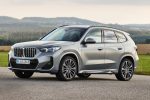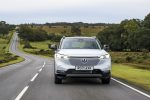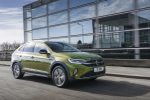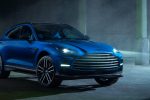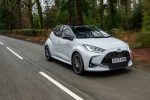Volkswagen T-Cross – Review
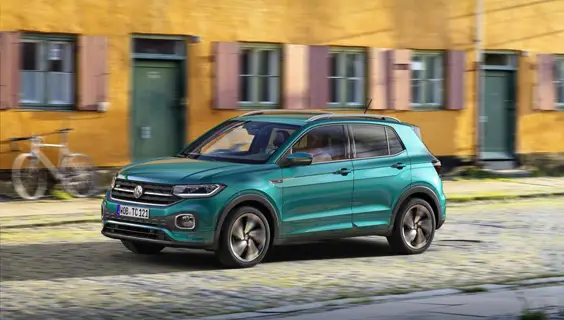
By Liam Bird
“Yes, but is the boot big enough to kidnap a sixty-six year-old Canadian bass-player?” Asked Mrs B the other evening over dinner. “Well…” I replied, “The backseat in the T-Cross does slide forward to give you more room”.
We didn’t really have any plans to kidnap anyone, Canadian, musical, or otherwise. It’s just that our week with Volkswagen’s most recent edition to its SUV line-up coincided with Geddy Lee – he’s the singer and bassist with Rush – signing copies of his book, in London. As a big fan of his work for far too many years to than I care mention, I was thus planning a trip to finally meet him. I mean buy his book. Hence Mrs B’s slightly surreal wit. Out here in the Far Unlit Unknown it’s those kind of ponderings that keep us entertained. Just us then, eh? Oh well…
With just three cylinders, 129lbft of torque, and 95 bhp to its name (a 113 bhp version is also available, so too a just-announced 1.6 TDI with 95 bhp and 184 lbft) the T-Cross is perhaps not the first thing you’d think of jumping into on a Saturday morning and heading to the Capital. Especially so three-up – my brother, also a Rush fan, came too. Nevertheless, even as the smallest SUV Volkswagen makes, the T-Cross proved more than up to the task.
“Most spacious car in its class”
Based on the same MQB A platform that underpins the current Polo, the T-Cross is thus needless-to-say similarly sized. It is in fact actually 54mm longer than the Polo, and 138mm taller, but perhaps the big news is that you sit 100mm higher. By doing so not only do you get a better view of what’s ahead of you on the M40 and Marylebone flyover, you free up more room inside the cabin; your legs go down, instead of out in front of you. So much more space in fact, that T-Cross offers more interior space than the larger (on the outside that is) T-Roc. Volkswagen therefore claim this is the most spacious car in its class.
Ah yes, the competition. Think Renault Capture, Nissan Juke, Kia Stonic, Ford EcoSport, Citroen’s C3 Aircross, and the very, very similar SEAT Arona (The Skoda Kamiq isn’t far off either – that’s a VW too). Urban SUVs, I think they call ‘em. And Like the T-Cross, the majority of the aforementioned are also based upon longstanding hatchbacks.
So then, why buy a hatchback-based SUV, rather than the hatchback upon which it’s based?
Fashion, probably. Although as you can probably tell from my music tastes I know little about such things. Apparently the demand for small SUVs is ever-increasing, and especially so ones that can be personalised. Volkswagen predict small SUV sales will grow from 6.4 million worldwide to 10.6 million in the next decade. They also offer an array of bold exterior colours, interior hues and alloy wheel options that allow the T-Cross to feel as bespoke and individual as a multi-selling car costing from £16,995 can be. Fortunately though, they sent me a nicely discreet plain white one.
Personalisation options notwithstanding, what you probably won’t buy a T-Cross for is its promised on-paper performance, or its off-road prowess. Despite those rugged looks and smatterings of extra body-cladding all T-Cross offerings are front-wheel drive only. Neither is it swift: 0-62 takes 11.5 seconds, terminal velocity where allowed is 112mph.
“Sense of solidity “
That said, there’s no hardship in punting the T-Cross along. There is an eagerness to VW’s familiar 3-cylinder engine that somehow makes it feel faster than those figures suggest, plus the 5-speed gearbox has a light and pleasing shift. Once up to speed the T-Cross seems happy to cruise all day long returning somewhere very close to its claimed 48.6 mpg whilst doing so. There’s a little wind noise from around the mirrors at motorway speeds, and a combination of that higher stance and some rather light steering means you can easily be knocked off line in a side-wind. Nevertheless having done so, I wouldn’t think twice about taking the T-Cross out of town.
Just like the Polo upon which it’s based, there’s pleasing sense of solidity to the T-Cross. Although when it comes the interior, and to steal a line from Mr Lee’s earlier work: You don’t get something for nothing.
Some of the plastics used on the door-trims are uncharacteristically hard, shiny and scratchy, and although every T-Cross comes with an eight-inch touchscreen as standard, which in S and SE models, also includes Bluetooth and a DAB radio, there’s no built-in satellite navigation: it’s a £725 option – unless that is your budget stretches to an SEL or R line model. You do get Apple CarPlay and Android Auto though – so you can use Google Maps, (Or stream 70’s prog rock from your phone). Should you need one in something this size, a reversing camera will set you back another £260. There were no parking sensors on “my” SE specced car either. Or for that matter heated seats – Mrs B always looks out for those.
The reason I mention such things is that on a Suzuki Vitara I drove recently, itself a small SUV, sat-nav, heated seats, Apple CarPlay, a reversing camera, Bluetooth and four-wheel drive (personally I think a four-wheel drive T-Cross would be absolutely perfect) were all standard fit. The Vitara was £20,799 on the road. “My” T-Cross came in at £19,165.
So then, in certain company the T-Cross can appear a tad expensive. Conversely, on the way home after a long day in London, and having used less than half a tank of fuel to get there in the first place, the size, comfort, relaxed feel, and instant Volkswagen ergonomic familiarity of the T-Cross also have the ability to make it feel just right.
And before you ask: No, we didn’t have an extra (reluctant, musical, and Canadian) passenger stored in the boot upon our return.
Volkswagen T-Cross SE 1.0 TSI 95 PS 5-Speed
Engine: 999 cc, 3-Cylinder, 12-Valve, turbo-charged Petrol
Transmission: 5 speed Manual. Front-wheel drive.
Power: 95 bhp @ 5,000 rpm
Torque: 129 lbft @ 2,000 – 3,500 rpm
0-62MPH: 11.5 Sec
Max Speed: 112 mph
CO2: 112 g/km
MPG: 48.6 (combined WLTP)
Price: from £18,805 otr (as tested £19,165)




